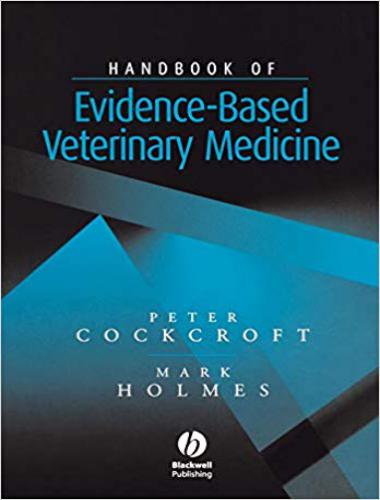Handbook of Evidence-Based Veterinary Medicine
Peter Cockcroft, Mark Holmes in 2003
The application of evidence-based veterinary medicine (EBVM) can assist in improving and optimizing the diagnosis, prognosis, control,
 treatment and ultimately the welfare of animals. It can also provide the user with a methodology for appropriate, patient orientated life-long, self-directed, learning. To practise evidence-based veterinary medicine we require a range of skills that we may not have.This book explains what evidence-based veterinary medicine is and shows how it can be applied to veterinary practice to improve the quality of care for patients and provide informed choices for owners. It provides the reader with a toolkit of skills necessary to practise evidence-based veterinary medicine.This book is aimed at practitioners but will be of interest to veterinary surgeons at any stage of their training or career wishing to learn about EBVM.
treatment and ultimately the welfare of animals. It can also provide the user with a methodology for appropriate, patient orientated life-long, self-directed, learning. To practise evidence-based veterinary medicine we require a range of skills that we may not have.This book explains what evidence-based veterinary medicine is and shows how it can be applied to veterinary practice to improve the quality of care for patients and provide informed choices for owners. It provides the reader with a toolkit of skills necessary to practise evidence-based veterinary medicine.This book is aimed at practitioners but will be of interest to veterinary surgeons at any stage of their training or career wishing to learn about EBVM.Evidence-based medicine has been defined as ‘the conscientious, explicit and judicious use of current best evidence in making decisions about the individual patients’. This means integrating individual clinical expertise with the best available clinical evidence from systematic research (Sackett et al. 2000). In veterinary medicine a broader, simpler definition may be appropriate, ‘Evidence-based veterinary medicine is the use of current best evidence in making clinical decisions’.
The authors explain how to:
- Transform information needs into a series of clinical questions that can be answered
- Search for best available external evidence
- Critically appraise the evidence for its validity and importance
- Apply the results in clinical practice
- Understand the process of diagnosis and use of clinical diagnostic decision support systems
- Perform a decision analysis
This book is for veterinary surgeons at any stage of their training or career who want to learn about evidence-based veterinary medicine (EBVM), but it has been written particularly for non-academic practitioners. It is an attempt to help veterinary surgeons practise EBVM and improve the quality of care for animal patients and provide informed choices for owners. This may take the form of knowing the specificity and sensitivity of a diagnostic test, understanding your own clinical reasoning, interpreting a diagnostic decision support system or understanding what an article about therapy/harm/prognosis is telling you. The practice of EBVM should form part of lifelong, self-directed learning without which you may rapidly become dangerously out of date.
[expand title=” “]
| PDF Size: 2 MB | Book Download Free |
[/expand]
Password: pdflibrary.net






